
I didn’t used to see the point of surveys…
I’m much more comfortable with scraping data, using software and relying on trends based on in-depth studies. I didn’t understand how it could be beneficial to read unstructured feedback from a few hundred people until I conducted a survey myself.
It’s not easy to know if what you’re doing is important for your ideal user or reader. You might believe that a certain marketing campaign or product feature is going to be the next big hit that brings customers, but without hearing the opinions of your audiences, you’re making another shot in the dark.
In July, I sent out the first reader survey we’ve done at Process Street. I built the processes and learned the benefits as I went along, and in this post I want to share them with you.
As a result of the survey, we received hundreds of common problems to solve in our articles, allowing us to create relevant and high-converting content. And, speaking of conversions, the follow-up conversations with respondents landed us a few new users and customers!
For a quick email template and a few hours of data entry, I’d say it’s well worth trying. In this article, I’m going to show you exactly how we surveyed our readers, and how it’s helped us improve our marketing and product. But first, an explanation of what I mean by feedback.
What is customer feedback?
In a very general sense, feedback is anything that anyone says about you. Whether that’s direct to you, through your support channel, in a conversation on Twitter, or in a review in a blog post. We’ve collated some of our customer feedback (a mix of feedback spotted in the wild, and feedback that came in through support) in Slack, in a channel called #user-feedback:
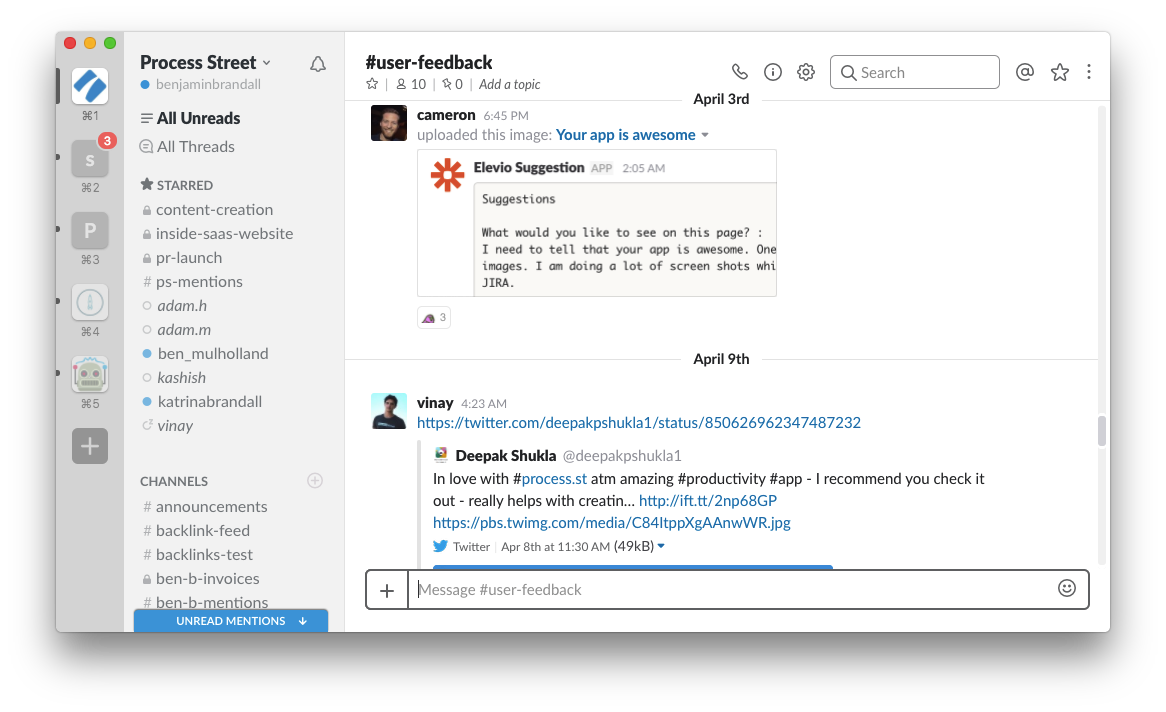
While hearing feedback from users over Twitter or in your blog comments is a pleasant surprise, it’s not how you go about getting targeted feedback on the most important things to your business. To get structured, useful feedback in big enough quantities to analyze, you’ll need to use a survey.
Why customer feedback surveys are your secret weapon
Some of the world’s best products have been built by iterating on feedback. Startups move so quickly and impact entire industries dramatically because the whole culture is focused around building something basic and functional, then making it better based on feedback.
In fact, you could argue that every successful product ever created has had to rely on feedback and iteration. For example, TVs are in color now because that’s what people wanted.
If you don’t know what it is that people want exactly, you can’t give it to them. On a broad scale, competitor research and following best practices can get you into the right ballpark, but to really refine the way you do things you need to hear it from the mouths of your audience.
Lars Lofgren, former marketing analyst at Kissmetrics, says that feedback answers the question of why your users act the way they do, and fills in the gaps left by the simple reporting of analytics.
“Why are people using one feature three times as often as another? Why do most of your customers stop creating accounts on the last step? Or what causes customers to use your product less frequently (and eventually stop altogether)?
When we match customer feedback to what we’re seeing in our analytics, we get a much clearer picture of what’s going on. Then we’ll know how to fix problems and go after the right opportunities.”
It’s easy to get analytics, but surveys take time, effort and consideration. Your competitors might not be using them to the fullest, so you can get the edge.
How we gathered hundreds of responses to find out the kind of content readers need
We knew what kinds of posts were opened and clicked by our blog subscribers, and we also knew which posts ranked well in Google. But what did our audience need that we couldn’t figure out by just looking at trends and data?
We decided to create a survey to find out.
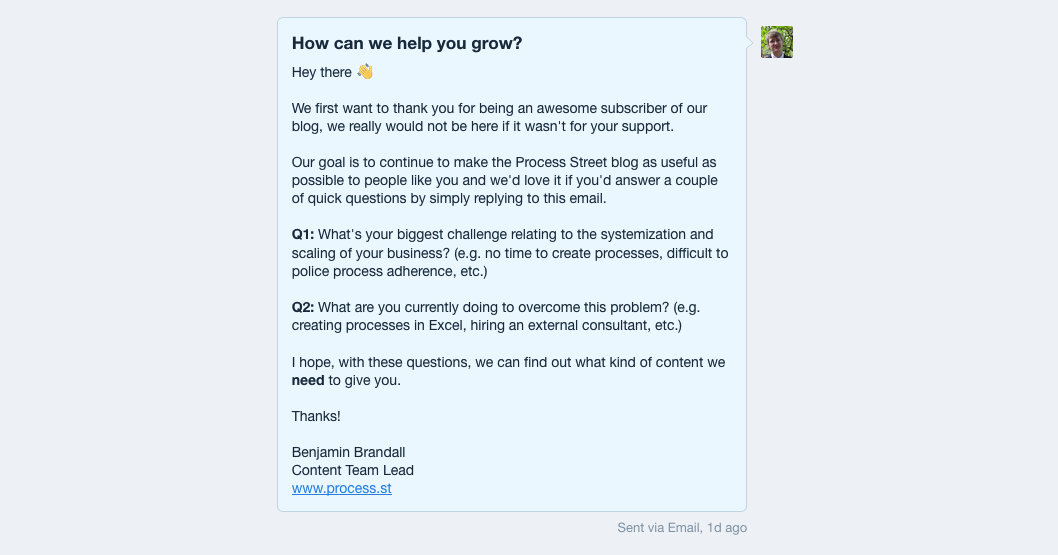
Why did we use a plain-text survey?
Even though it would have been easier for me to process if I’d used something like Typeform to gather the results, the simplicity of plain text made me think I’d get more responses. There’s less friction, mystery and doubt when it’s as simple as hitting reply. Readers know exactly how many questions there are in the survey and can more easily judge if they have the time or energy.
Also, a secondary benefit is that Gmail and other email tools prioritize emails from addresses that you’ve replied to before. When I was running my personal blog, I had to up 80% open rates because I often asked readers to reply with their answers to a question, or replies to my content. If your email newsletters are always getting lost in the Promotions tab, getting replies could be a way to fix that.
Why did we choose these particular questions?
We write a lot about processes, and try to cover all the bases. We’ve written posts targeted at big businesses looking to overhaul their entire operations, and posts for companies that want to operate light, with as few formalities as possible.
But, in the middle of it all, we didn’t really stop to think about what exactly it is that trips businesses up. We realized that most businesses don’t think processes are worth the time and effort, and found that many rely on Microsoft Word for documentation. With that kind of information, we don’t need to cover all the bases and miss as often as we hit; we can write for 80% of the audience almost 100% of the time, and have much better success with our content. That’s something we couldn’t have known before.
We got almost 100 responses to the above feedback request email. Some were short, but an overwhelming amount of them contained multiple paragraphs of useful information and showed us our readers had problems we didn’t really know existed.
How we processed the feedback and turned it into structured data
A big stack of email responses isn’t much good, though. We needed to format it up and turn it into useful data. To do this, it was just as simple as manual work. We manage communication with our users and readers using Intercom (it’s one of the few tools we’d recommend as essential). Every response that came back to that survey came to my Intercom inbox, where I could easily process the answers.
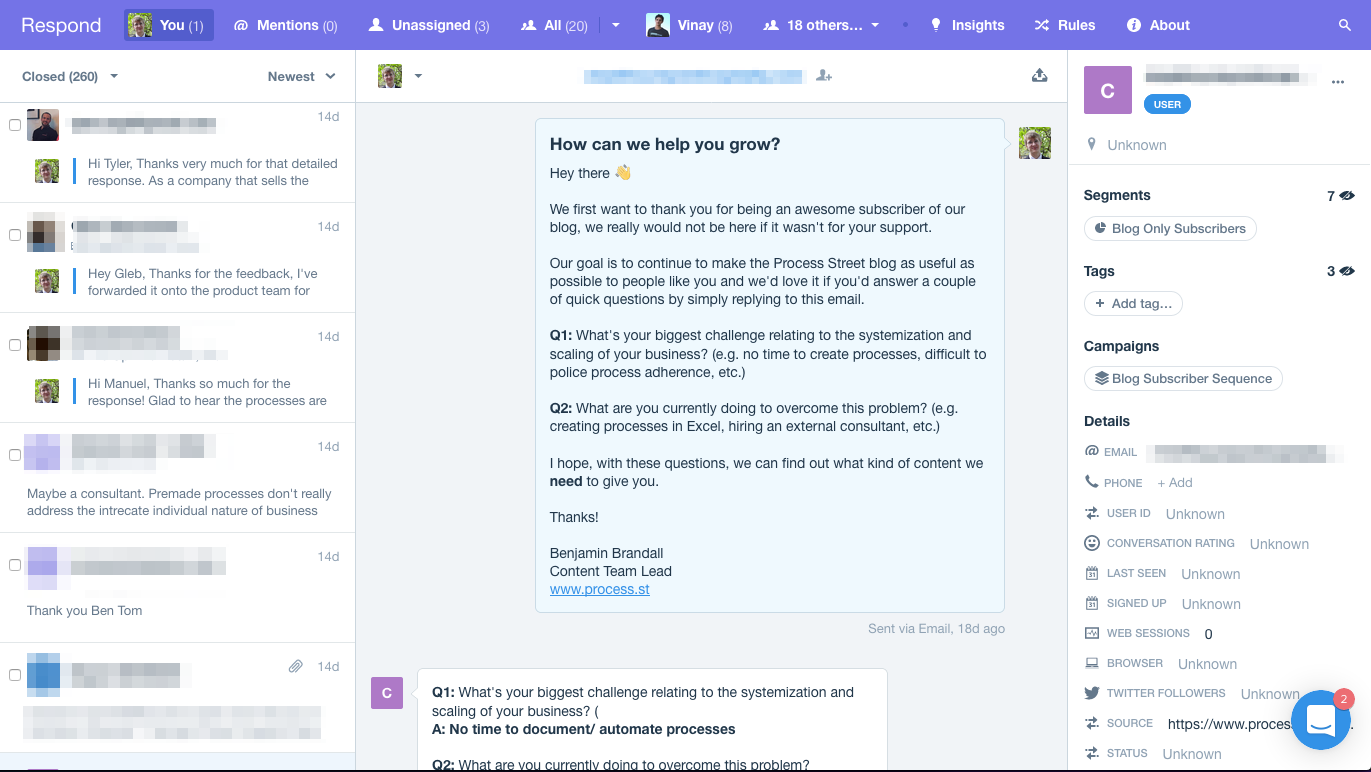
I made sure to respond to every answer with one of several potential answers. If the reader had responded saying they had no time, I asked them whether or not they thought a consultant or more pre-made processes would be helpful. Halfway through the survey, one big pain point was becoming obvious: process adherence.
Using the audience’s responses, I wrote a post the same week the survey launched and then sent a link to every future respondent who said they were having trouble with getting their team to adhere to processes. Otherwise, I just thanked them for their response and logged it in Airtable.
Logging results in Airtable
Airtable is like Excel, but much easier to use and more powerful. We store all kinds of data in this centralized, cloud-based database, including survey responses.
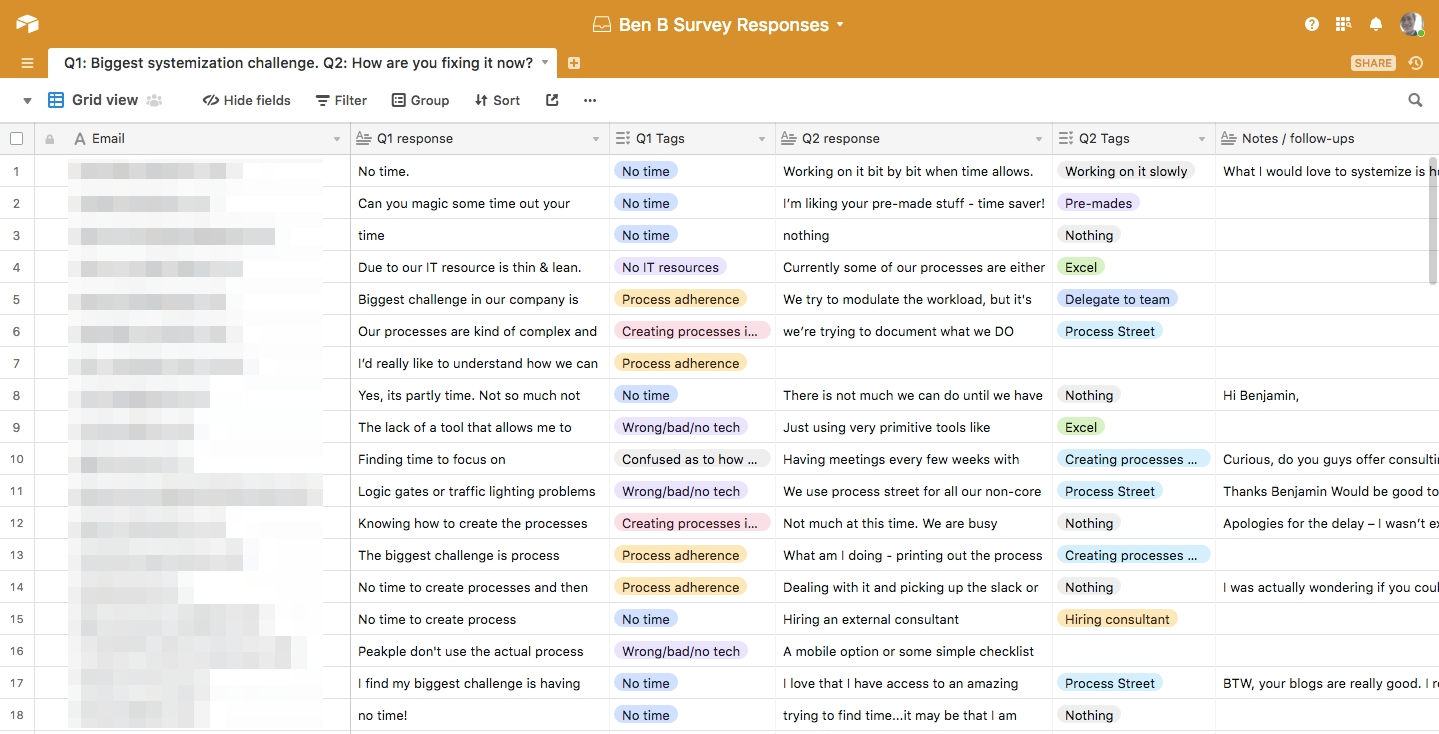
I manually pasted the respondent’s email address and answers into separate fields, and then when I’d collected around 50 responses I went in and tagged them so we could analyze the trends. Each question had pretty standard answers, so it was easy to use only around 10 different tags, giving us concrete, consistent data.
Note: If you were to run the survey using a tool like Typeform, you could use Zapier to automatically send the responses to Airtable!
Creating saved replies
On some days, the replies were coming in so quickly it took me all morning to process them. As it usually is when you’re starting something new, I went in unprepared and not quite knowing what to expect. But, I quickly started developing systems to help me streamline it and remember to send the most helpful messages to everyone. The main part of that system was writing saved replies.
Since it’s a temporary project, I created the saved replies in aText (one of my favorite time-saving tools) instead of adding them to Intercom for the whole team to use. I only really needed three responses since most replies fell neatly into one of the three categories.
I had a generic thank you response:
Thanks very much for getting back to me! I hope we can make our content even more useful to you in the future, based on your situation
I had a follow-up question for when readers said they had no time to create processes:
Thanks for the responses!
Since you’re pressed for time, what do you think would help you out the most? More pre-made processes you could use out of the box? Direct integrations? A consultant?
And a content suggestion for readers who said they had problems with process adherence:
We’ve gotten a lot of people saying that getting people to follow the process is hard. So much so, I wrote a blog post about process adherence yesterday to try and solve everyone’s issues: https://www.process.st/process-adherence/
I hope it helps
Bonuses we found along the way
The replies weren’t just good for feedback. I got chatting to users, and even interviewed a process consultant based on their response and a comment they made on our blog. A lot of what readers told us also applied to feedback on the Process Street product itself. In cases like that, I tagged those messages #user-feedback in Intercom, and then they were sent automatically to ProductBoard to be processed by the product and development teams. (Read more about the wider context of that process here.)
The survey emails also opened up a dialog between me and people directly struggling with processes, which turned out to have benefits of its own…
How our survey helped generate content ideas and convert users
We collated our responses in Airtable, which made it easy to tag them. Once tagged, we can quickly get a rough idea of the biggest problems our users have, at a glance:
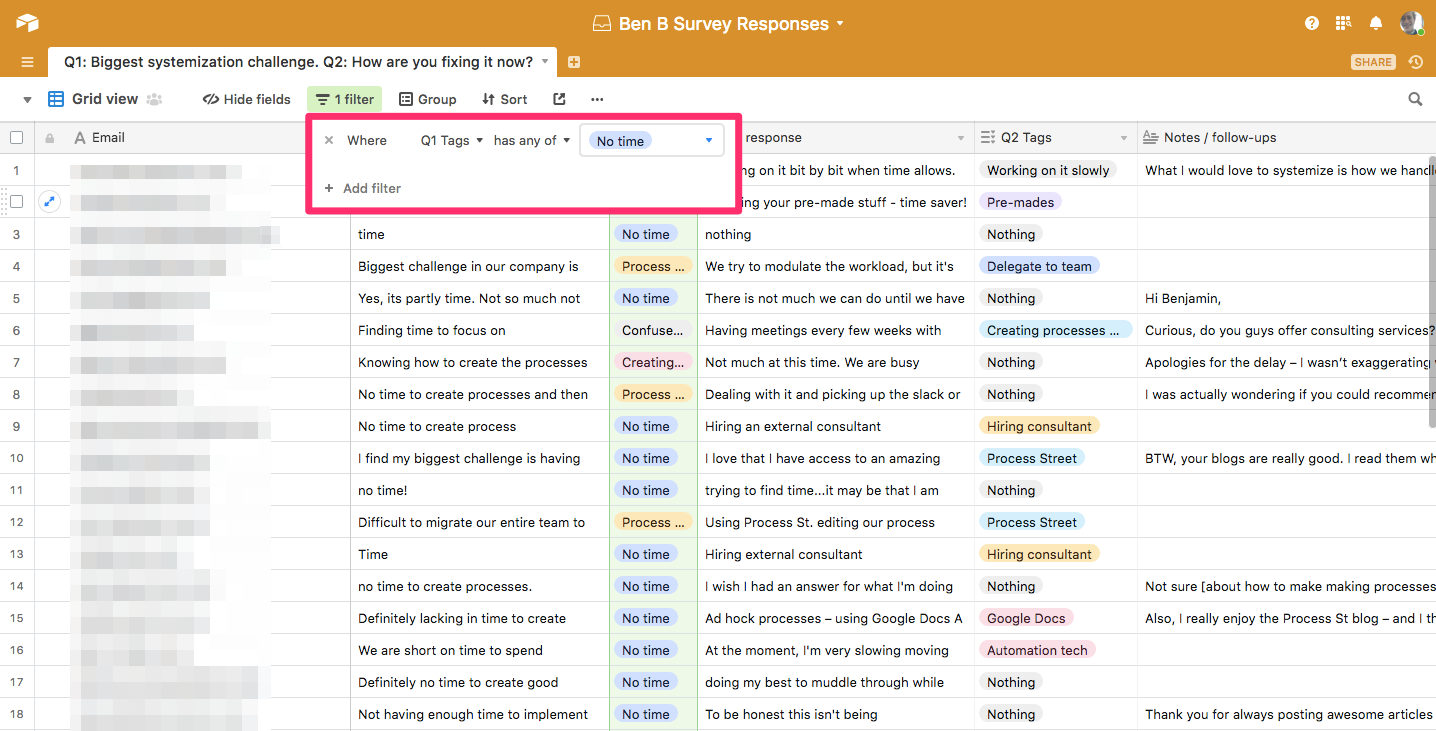
For example, 44% of the responses say that they don’t create processes because they don’t have the time to do it. With that, we could write guides on creating processes quickly, guides on delegating processes to your team, or even guides that recommend using process consultants. That’s important information for these readers, but we wouldn’t have known it without a survey.
We also found that a lot of readers were in the middle of evaluating Process Street, or hadn’t initially realized that Process Street would be a solution for their problems. In a sense, reaching out and having a conversation reactivated these users, and resulted in a few extra conversions we wouldn’t have otherwise gotten!
How to use Process Street to process customer feedback
At first glance, Process Street seems like a way to run checklists and document your workflows. While it is that, it can also be used as a way to capture and process data from other apps. We use Process Street to process support tickets for analysis and store any customer feedback that comes our way. That way, we can plan our product roadmap and make commonly requested updates.
If you want to do the same, it’s as easy as connecting your Typeform survey to Zapier, and creating a zap that triggers a new Process Street checklist every time someone fills the survey in. The Process Street template you could use to process feedback could be this pre-made one we made for you:
If you want to automatically run a checklist to process your new form responses, you can add that template to your Process Street account and then connect Typeform to Zapier with the button below:
You can find out more about integrating Process Street with Typeform and get a full tutorial in our help doc here.
But, for now, I hope this post has helped you see how easy it is to get valuable insight from your customers or readers with just a quick email and a few hours of work. Share your own tips in the comments! 🙂







Benjamin Brandall
Benjamin Brandall is a content marketer at Process Street.